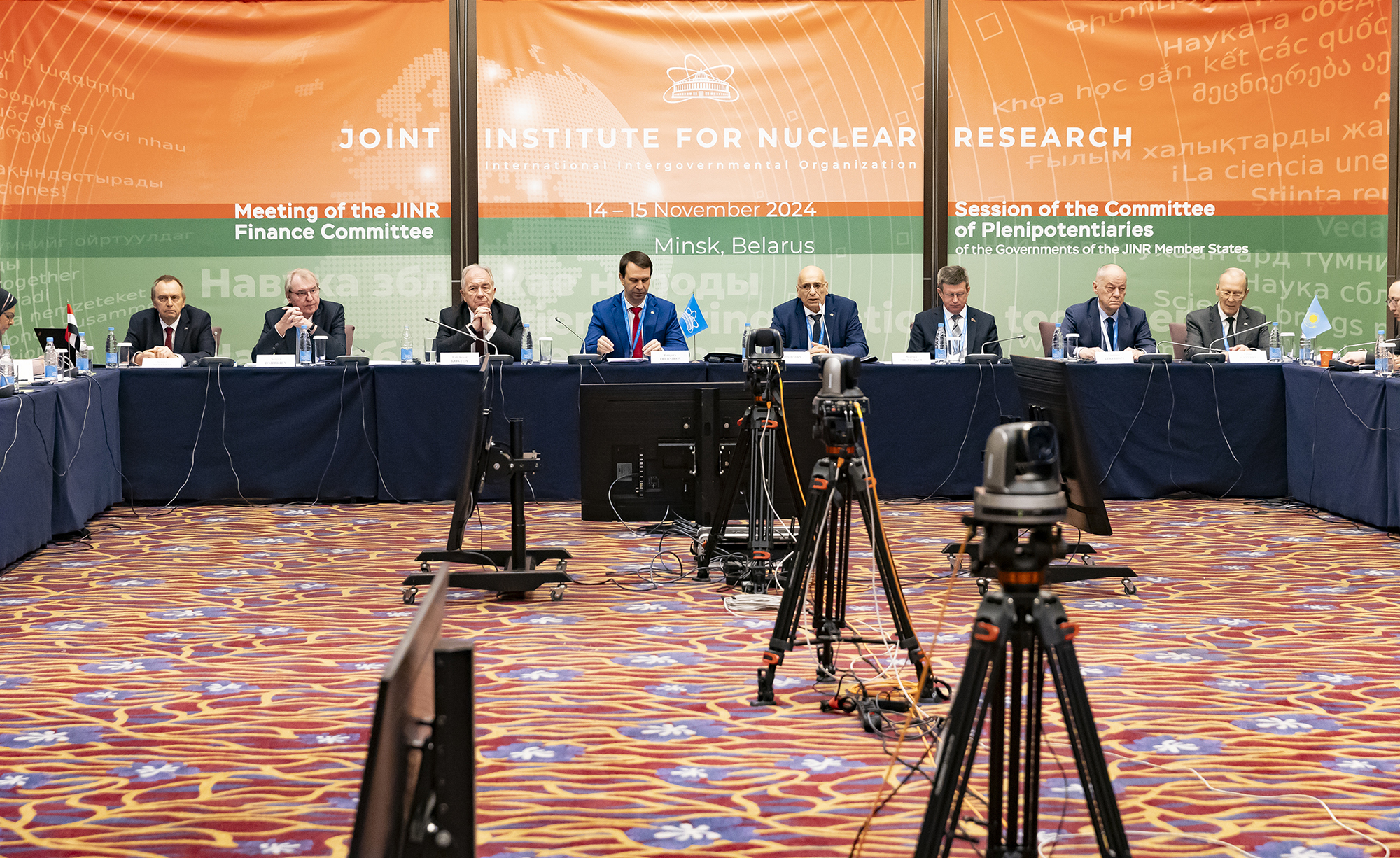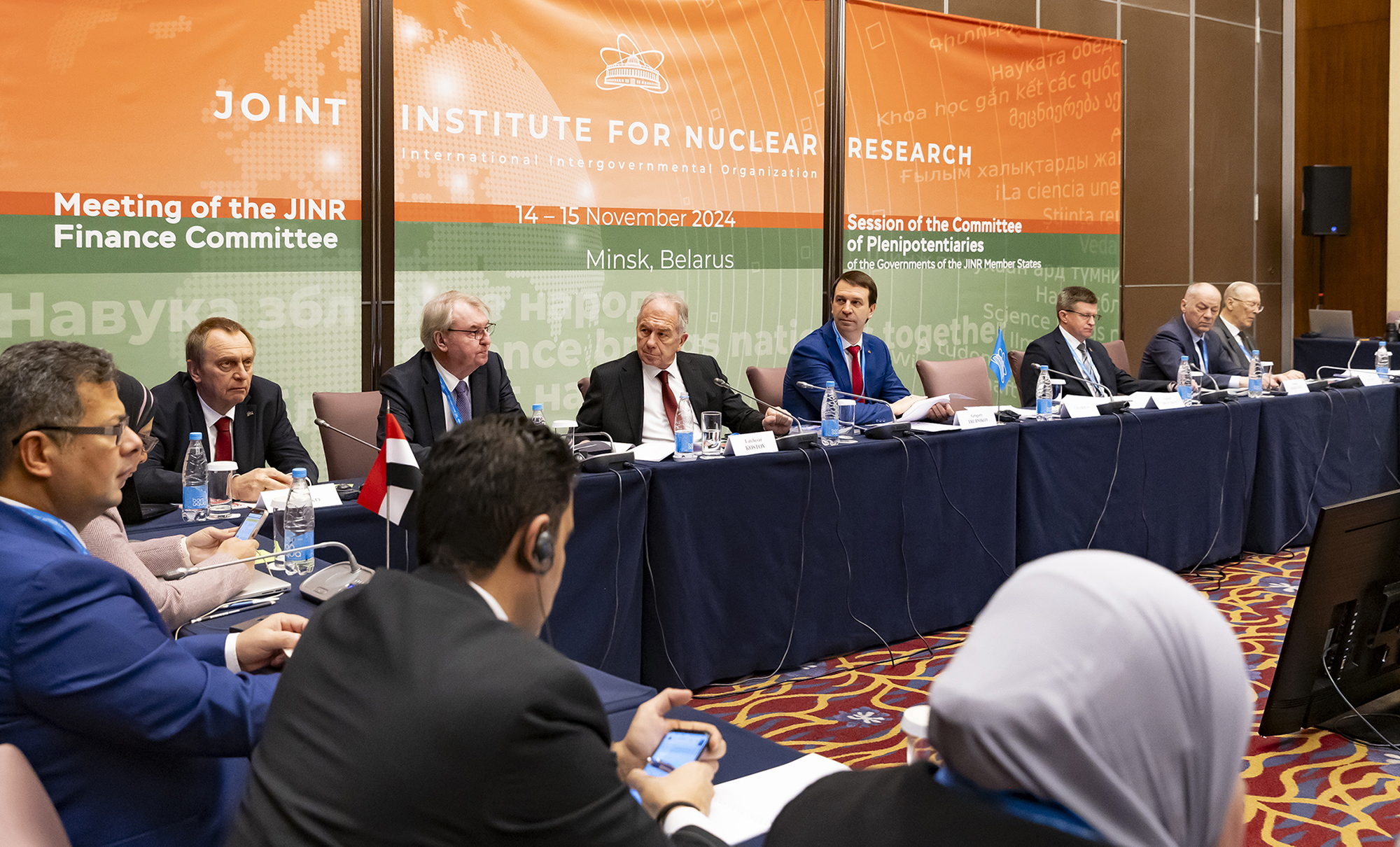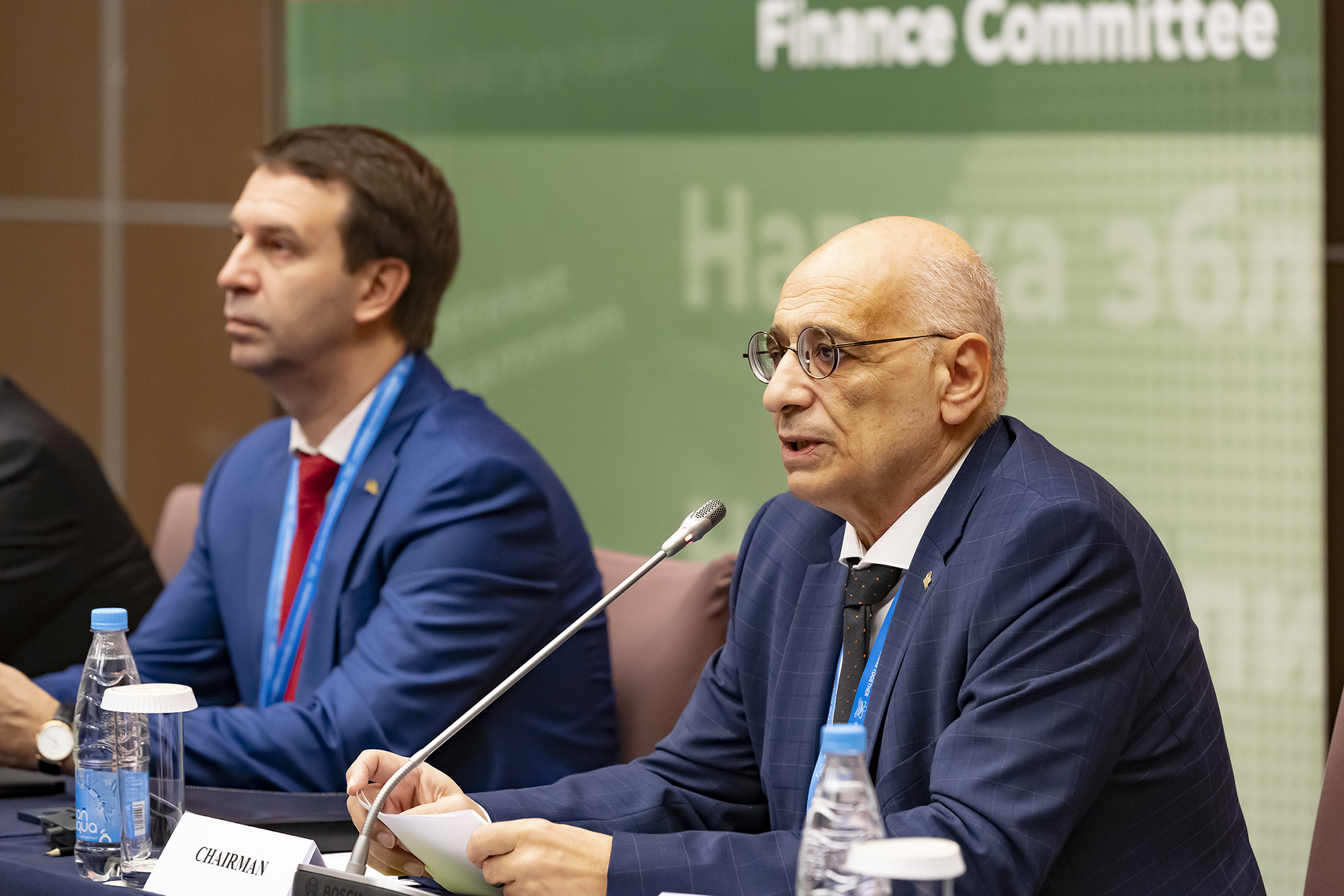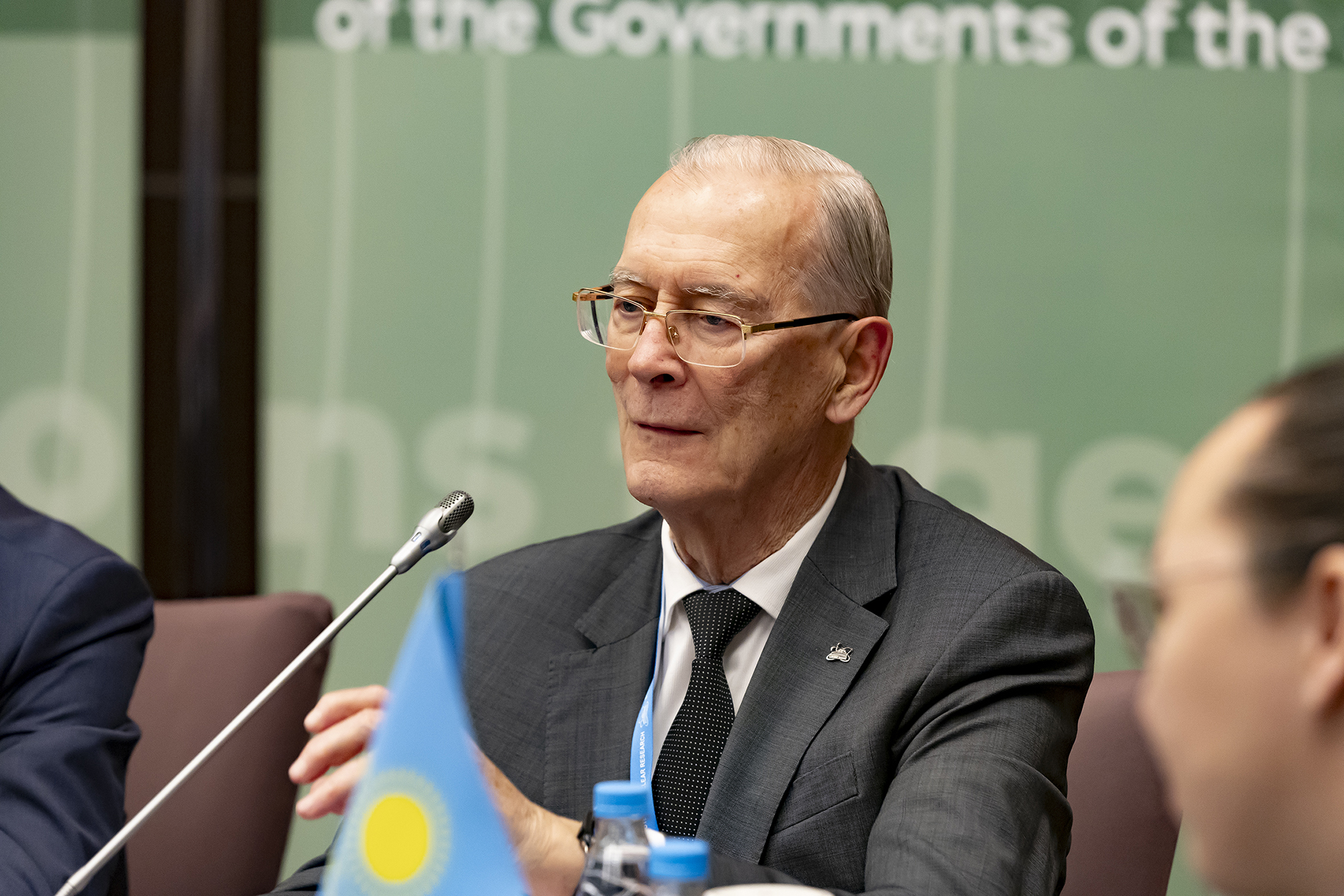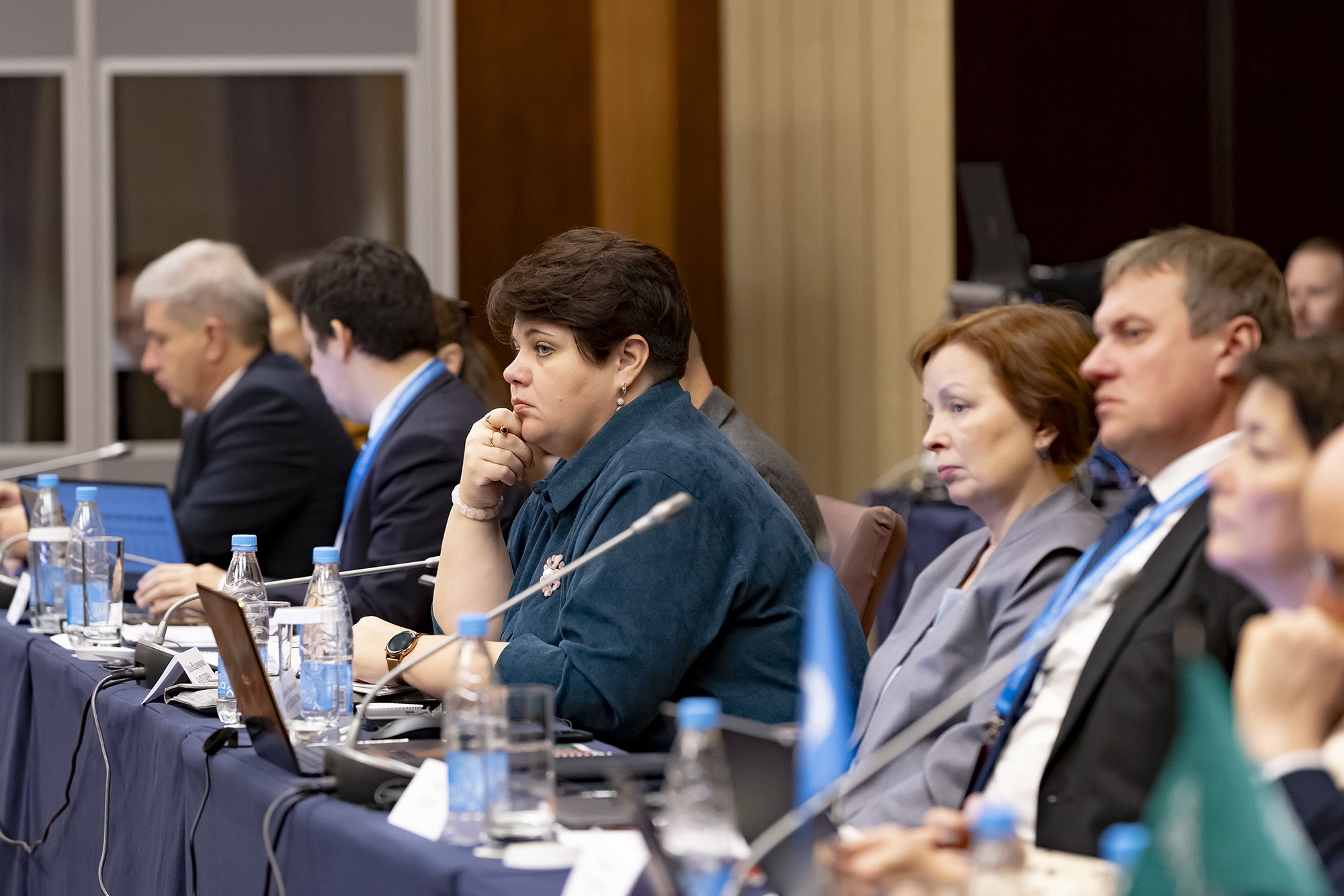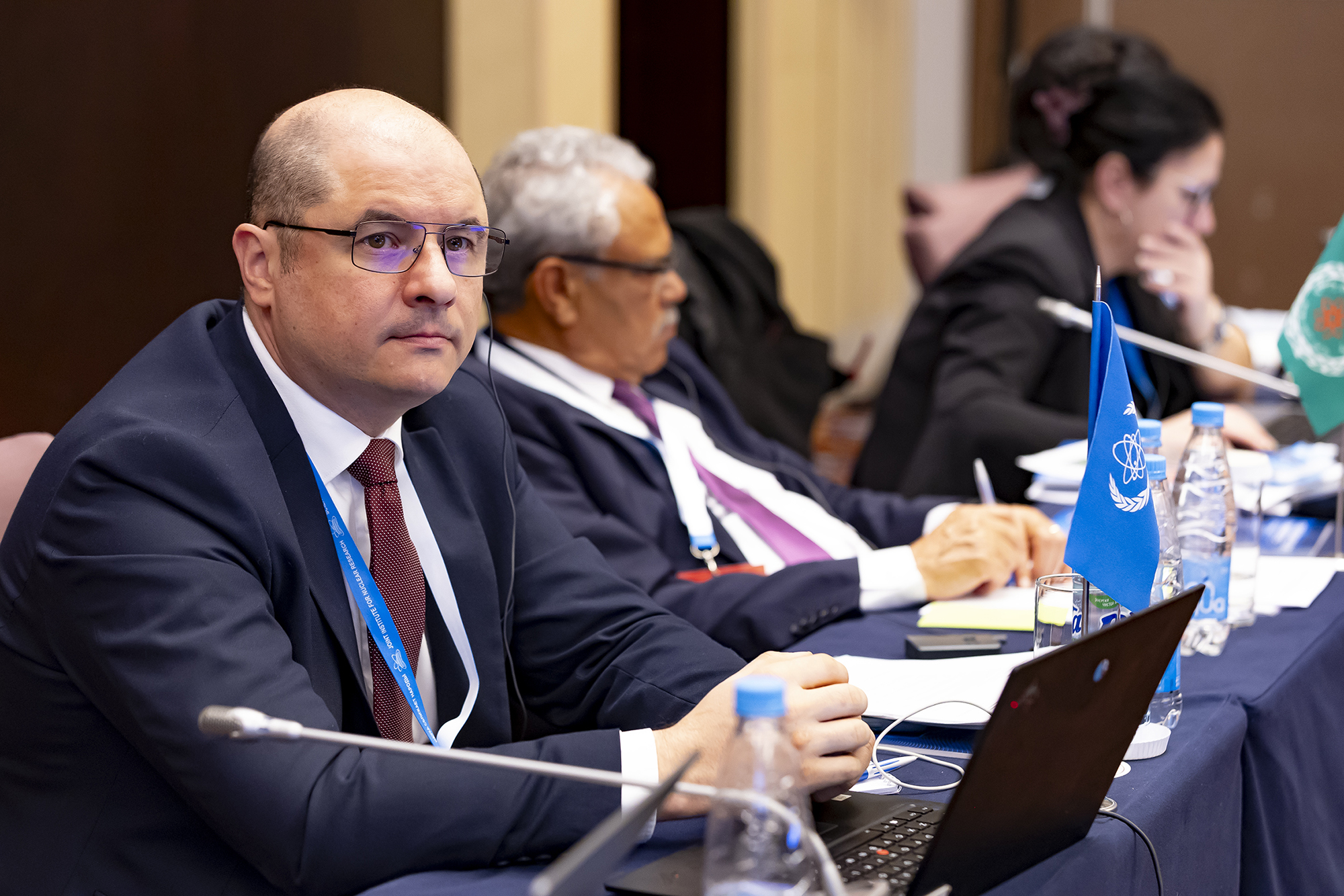Unity of strong science: CP session results in Minsk
News, 20 November 2024
On 15 November, a session of the Committee of Plenipotentiaries of the Governments of the JINR Member States of the Joint Institute for Nuclear Research (CP JINR) took place in the capital of the Republic of Belarus under the chairmanship of the Plenipotentiary Representative of the Government of Georgia to JINR Arsen Khvedelidze. The CP members got acquainted with the main scientific results of the Institute, its activities in personnel training, and social infrastructure development. Following the meeting, the Committee approved the Institute’s budget for 2025 and elected new members of the Scientific Council. Three JINR employees received state awards of the Russian Federation and Belarus.
The CP JINR session started with a moment of silence in memory of Bekhzod S. Yuldashev (09/05/1945 – 28/08/2024), JINR Honorary Doctor and Plenipotentiary Representative of the Government of the Republic of Uzbekistan, who made a significant contribution to the development of world science. He was the leader of a number of major projects on nuclear safety and security and practical solutions to nuclear non-proliferation issues. With the active participation of Bekhzod Yuldashev, ties between scientists of Uzbekistan and JINR strengthened as well as the Institute’s partnership with universities of the Republic in personnel training for large scientific projects.
Chair of the State Committee on Science and Technology of Belarus (SCST), Plenipotentiary Representative of the Government of the Republic of Belarus to JINR Sergey Shlychkov addressed the meeting participants with a welcoming speech. He noted the successful development of Belarus’ participation in activities of the Joint Institute and the prospects for its expansion.
“The CP session is taking place for the third time in Belarus. For us, this is not only a necessary continuation of JINR’s course to deepen cooperation with the Member States, but also recognition of our country’s contribution,” Sergey Shlychkov stressed. According to him, this event promotes the strengthening of both ties within the Institute and the development of bilateral scientific cooperation.
Opening the session, Grigory Trubnikov, Director of the Joint Institute for Nuclear Research, Academician of the Russian Academy of Sciences, gave a talk on the current JINR activities, the implementation of the Seven-Year Plan for the Development of the Institute in 2024-2030, and the main scientific results.
One of the most important events in the life of the Institute this year was the June visit of the President of the Russian Federation Vladimir Putin to Dubna. “The main direction outlined by the President of Russia is that the Russian Federation is open to joint research in basic science and is ready to participate in international projects on the territory of any country on terms of equal and mutually respectful interaction,” the JINR Director emphasised.
The issue of renewing the agreement on the residence of the Institute, signed in 1995, was discussed with Vladimir Putin. Active work is underway with the departments of the Russian Federation to update the document.
The Institute Director announced the most important indicators of JINR activity. The organization has employees from 33 countries of the world. More than 800 students and young specialists have visited JINR this year to participate in internships, educational programmes and to prepare and defence graduation papers and dissertations. Grigory Trubnikov noted that the average income of the Institute’s employees increased by 18% during the year and suggested that next year’s salary increase should be similar to the 2024 level. In addition, it was proposed to almost double the payments to PhDs and postdoctoral fellows, which would help motivate young researchers and increase the intellectual capacity of the Institute.
Milestones of research work
Grigory Trubnikov presented the most remarkable works and publications in each of the seven laboratories of the Joint Institute. He highlighted two papers by authors from the Laboratory of Theoretical Physics supporting the flagship JINR experiments: on lattice computations of mixed-phase quark-gluon matter at the energies at which the NICA Complex will operate, and on modelling the superheavy element decay reactions.
About 700 people work simultaneously on the collider assembly at the Laboratory of High Energy Physics. “NICA beams are in high demand by our major partners,” Grigory Trubnikov said. This year, an agreement was reached with Roscosmos, which will invest in the creation of a laboratory building of the Institute of Biomedical Problems of the Russian Academy of Sciences on the territory of JINR, where materials science studies of the ROS Space Station shells and radiobiological studies using primates will be carried out to ensure the safety of long-term space expeditions.
The Laboratory of Nuclear Problems, celebrating its 75th anniversary this year, has finished another expedition to Lake Baikal. In September, the head of the COMET Project Collaboration visited JINR. DLNP JINR Director Evgeny Yakushev is preparing to visit Japan to negotiate with the leadership of the High Energy Accelerator Research Organization on expanding JINR’s participation in the experiments of this scientific centre.
The modernisation of the U400-M Cyclotron has been completed in the Laboratory of Nuclear Reactions. The results of the first experiment at the U400-M for the search and study of dineutron and tetraneutron correlations on helium beams are being analysed. Over the past 10 months, four floors of the experimental hall of the U400-R Accelerator Complex have been erected. Experiments continue at the Superheavy Element Factory in preparation for the synthesis of chemical elements 119 and 120, and a modern radiochemical laboratory is under construction.
In the Laboratory of Neutron Physics, cathode materials for sodium-ion batteries are being studied together with Belarusian colleagues. The scientific programme at the IBR-2 Reactor is scheduled to resume in the first half of next year. A prototype BJN Spectrometer has been built, which in two years will be one of the best facilities in the world in terms of accuracy.
“Our Institute continues to actively participate in international experiments. We are keeping all our obligations,” Grigory Trubnikov stressed. In September, the CERN Council decided to extend the cooperation agreement with JINR for the next five years. 180 JINR employees are currently working for the European Organization for Nuclear Research. JINR scientists take part in the NA64 and NA61 Experiments. The Institute produced and delivered new components of the CMS Detector of the Large Hadron Collider to CERN . The VBLHEP researchers fulfil their obligations in terms of modernising the ATLAS Detector. BLTP and MLIT are also involved in processing experimental data. The Joint Institute continues to analyse data from the STAR Experiment at Brookhaven National Laboratory (USA).
The Laboratory of Information Technologies annually upgrades the computing infrastructure of the Institute ahead of schedule. The MLIT JINR Heterogeneous Computing Platform holds the first place in the world in terms of CMS data analysis. “Computer clusters in the JINR Member States operate as a single computing network. This way, we can remotely solve grand challenges,” said the JINR Director.
The Laboratory of Radiation Biology at JINR continues research in mixed beam therapy, i.e. simultaneous irradiation of tumours with multiple types of radiation. The Laboratory has published an astrobiology book summarising the interim results of the research on the origin of life on Earth conducted by LRB and several Russian Academy of Sciences (RAS) institutes.
Education and science
The Engineers of the Future physics textbook for 5-9 grade schoolchildren, developed by the JINR University Centre employees, has been approved at the state level. More than 50 Russian cities will receive it as an educational and methodological complex. The textbook and accompanying materials will be translated into English.
This year, JINR held a significant number of student schools and internships, attended by more 400 participants from Armenia, Belarus, Egypt, Kazakhstan, the Russian Federation, Serbia, South Africa, and Vietnam. In addition, there are schools for physics teachers and schoolchildren from Member States.
The Institute implements the specialised international JINR Postdoctoral Programme and the JINR Fellowship Programme. Each received more than a hundred applications from all over the world for selection. As part of these programmes, the Institute employs 15 postdoctoral students and 10 fellowship holders. Soon, a separate programme will be launched for Latin American countries, and the idea of creating a programme for Asian and African countries is being considered.
JINR provides such cooperation opportunity as associate employment. This format allows scientists from Member States to use the JINR infrastructure and access the databases and other resources while keeping their main job. Over the years, 150 people from all Member States worked at JINR as associate employees.
About 50 major conferences and 35-40 candidate’s and doctoral dissertation defences take place at JINR each year.
Grigory Trubnikov presented an idea to create a programme to support interlaboratory innovative projects. He noted that the Institute currently has about 10 promising ideas of young employees who, in addition to their main work, would like to engage in small projects dedicated to semiconductor microdetectors, new algorithms, etc. The Institute’s Directorate expects to launch this startup programme in 2025.
Developing cooperation
Over the past six months, JINR delegations have held meetings with specialised agencies of the Member States and partner countries. Joint work with scientific and educational centres in Mexico and India is intensifying. A meeting of the Joint Coordinating Committee on JINR-Vietnam Cooperation was held in autumn. JINR’s partnership with China became multilateral. The JINR delegation took part in the work of the General Assembly of the Union of Pure and Applied Physics.
Prior to the Institute’s anniversary in 2026, new JINR exhibition spaces are being created at the International Conference Centre and the former Dubna Administration building at Mir Square.
JINR employees won notable awards. JINR Scientific Leader Victor Matveev received the RAS Bogoliubov Medal, MLIT Scientific Leader Vladimir Korenkov was honoured with the Friendship Medal of Mongolia, and a FLNP JINR senior researcher Mikhail Kiselev won the Pharmaceutics 2022 Best Paper Award.
JINR is launching a new digital scientific peer-reviewed journal, Natural Science Review. The first issue will be published this year. The journal will have four issues a year in English and will publish not only original scientific articles and reviews, but also other results of intellectual work, such as technical projects, program codes, etc.
In conclusion, Grigory Trubnikov spoke about the participation of the Republic of Belarus in JINR. Belarusian scientists are involved in all major projects of the Institute. Coordination committee meetings and mutual visits are held annually. Belarusian institutes and enterprises developed superconducting magnets for the NICA Complex. Organizations conduct joint work on superconducting material creation (niobium resonators), laser metrology, and accelerator technology.
Discussing NICA progress
Project Leader, Vice-Director of the Joint Institute Vladimir Kekelidze made a presentation on the progress of the creation and launch of the basic configuration of the NICA Accelerator Complex and the latest decisions of the Supervisory Board of the Project.
The equipment installed in the collider ring is currently being tested and adjusted. The Institute reached agreements with Russian companies on the production of required magnetic optic elements for the NICA Injection Complex and assistance in creating a power supply system, the installation of which is scheduled for May 2025. The cryogenic compressor station for liquid helium and nitrogen production, the most productive in Russia in terms of helium, was commissioned. All compressors, oil purification systems, and the helium delivery line are launched and ready to ensure the full functioning of the accelerator complex.
Vladimir Kekelidze noted the success of international collaborations participating in the NICA experiments. The cryogenic test cycle of the MPD Detector solenoid magnet is complete, and the detector is now being cooled down to its operating temperature (-269 °C). The BM@N Experiment brought the first physical results, which became the basis for the defence of the first dissertations. Full-scale work on the creation of the SPD Facility begins. Applied research as part of the ARIADNA Collaboration is actively being developed.
The presentation included the roadmap of the NICA Project, according to which the launch of the collider and the start of international research are scheduled for the end of summer 2025. According to the JINR Vice-Director, the construction of the complex is 98% complete, with the installation and commissioning of engineering equipment currently underway to provide the necessary technical conditions for the facility’s operation.
At the meeting of the Supervisory Board of the NICA Project on 6 November, an updated launch plan for the basic configuration of the VBLHEP accelerator complex was approved.
CP meeting results
The draft budget of the Joint Institute for Nuclear Research for 2025, along with the indicative contributions of the Member States for 2026-2028, were approved by the JINR Committee of Plenipotentiaries. This decision was made after the detailed presentation by Head of the JINR Budget and Economic Policy Department Nikolai Kalinin and a speech by Finance Committee Chair, Deputy Head of the Ministry of Education and Science of Russia Andrey Omelchuk who reviewed the results of the FC meeting on 14 November 2024.
“JINR’s initiatives and willingness to collaborate not only promote science in Russia, but also create bridges for international scientific exchange. Further deepening of partnership with other countries and international organizations is the key to sustainable development and establishment of more scientific ties. In addition, in order to achieve these goals and ensure a stable financial foundation for the implementation of the Seven-Year Plan for the Development of JINR 2024-2030, there will be an annual 5% increase in contributions from Member States. This decision is aimed at maintaining and strengthening the research infrastructure that promotes scientific achievements, including advanced research at megascience facilities. In particular, the achievements of the NICA Accelerator Complex and its collaborations play a key role in the development of fundamental scientific research,” Andrey Omelchuk said.
The Committee of Plenipotentiaries reviewed and approved the recommendations of the 135th and 136th sessions of the JINR Scientific Council, approved the List of JINR Officials and the Topical Plan for JINR Research and International Cooperation for 2025. In addition, at the suggestion of the Director of the Institute Grigory Trubnikov, Professor Raghunath Sahoo of the Indian Indore Institute of Science and Technology and Director General of the Institute of Plasma Physics of the Chinese Academy of Sciences Song Yuntao were elected new members of the JINR Scientific Council.
Director of the Institute for Nuclear Problems of the Belarusian State University (BSU) Sergey Maksimenko made a presentation on the main BSU research directions and the potential for international cooperation. The Institute for Nuclear Problems, on behalf of the Plenipotentiary Representative of the Republic of Belarus in JINR, provides organizational support for research and development carried out as part of joint projects with the participation of engineering and scientific centres of the country.
In his speech, Sergey Maksimenko noted the importance of interdisciplinary research cooperation. He stressed: “There can be no science without ties between the researchers. We must always keep in mind not only contracts or projects, but also the incredibly important opportunity to discuss current scientific issues.” He expressed hope for holding even more joint scientific conferences and events with JINR in 2025.
 In the final part of the meeting programme, the ceremony of awarding state awards of the Russian Federation and the Republic of Belarus to employees of the Joint Institute took place.
In the final part of the meeting programme, the ceremony of awarding state awards of the Russian Federation and the Republic of Belarus to employees of the Joint Institute took place.
Based on the order of the State Committee on Science and Technology of the Republic of Belarus, Head of the VBLHEP JINR Track Detectors Sector Sergey Movchan and a leading specialist in contractual work of the JINR Budget and Economic Policy Department Olga Maslovskaya were awarded a Certificate of Honour for significant personal contribution to international scientific and technical cooperation.
By decree of the President of the Russian Federation, JINR Vice Director Latchesar Kostov received the Order of Friendship for his great contribution to strengthening the Russian-Bulgarian partnership in nuclear energy and the development of intergovernmental cooperation in fundamental and applied research.
 “It is a great honour for me to receive this award. This is recognition of my life’s work,” Vice-Director said. “On the one hand, this is a confirmation of Bulgaria’s outstanding contribution to international scientific cooperation. On the other hand, it is an acknowledgement of the broad scientific activities of the Joint Institute for Nuclear Research, successfully sticking to the motto “Science brings nations together”.
“It is a great honour for me to receive this award. This is recognition of my life’s work,” Vice-Director said. “On the one hand, this is a confirmation of Bulgaria’s outstanding contribution to international scientific cooperation. On the other hand, it is an acknowledgement of the broad scientific activities of the Joint Institute for Nuclear Research, successfully sticking to the motto “Science brings nations together”.
The next session of the Committee of Plenipotentiaries of the Governments of the Member States of the Joint Institute for Nuclear Research will take place in March 2025. A meeting of the JINR Finance Committee will be held the day before.
